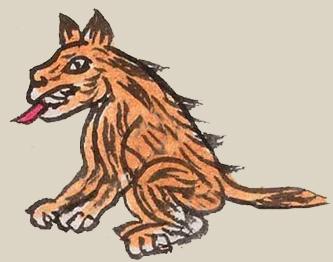coyotl (Mdz5v)
coyotl (Mdz5v)
This element for coyotl) has been carved from the compound sign for the place name, Coyoacan. It shows a seated coyote in profile, looking to our left. Its coat is painted orange and textured. Its toes are white. The tongue is protruding from the mouth, and some of its teeth are visible. In another glyph in this collection, we see the coyotl) represented only by its head, just as we can see the eagle (cuauhtli) represented only by its head.
Stephanie Wood
The animal called the coyotl), esteemed by the Aztecs, can be found in codices, carvings, place names, and personal names. An important example is Nezahualcoyotl of Tetzcoco, associated with music and poetry. The coyotl also captured the attention and imagination of Europeans to the extent that the term entered Spanish, and from Spanish, entered English. The pronunciation of the word coyote in English some some places in the U.S. West actually comes closer to the original Nahuatl pronunciation, with the emphasis on the first syllable and the dropping of the final vowel that we know in Spanish.
Stephanie Wood
c. 1541, but by 1553 at the latest
Jeff Haskett-Wood
Ed Trager
coyotes, animals, furry, hairy, tongues

coyo(tl), coyote, https://nahuatl.wired-humanities.org/content/coyotl
coyote
el coyote
Stephanie Wood
Codex Mendoza, folio 05 verso, https://digital.bodleian.ox.ac.uk/objects/2fea788e-2aa2-4f08-b6d9-648c00..., image 21 of 188.
The Bodleian Libraries, University of Oxford, hold the original manuscript, the MS. Arch. Selden. A. 1. This image is published here under the UK Creative Commons, “Attribution-NonCommercial-ShareAlike 3.0 License” (CC-BY-NC-SA 3.0).

